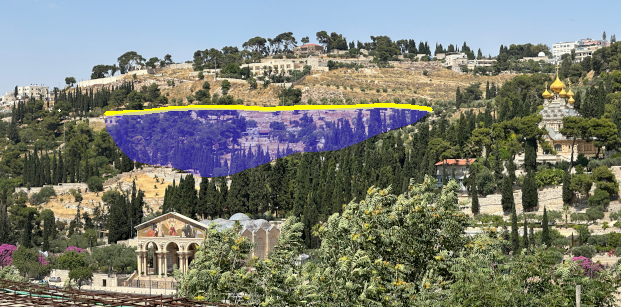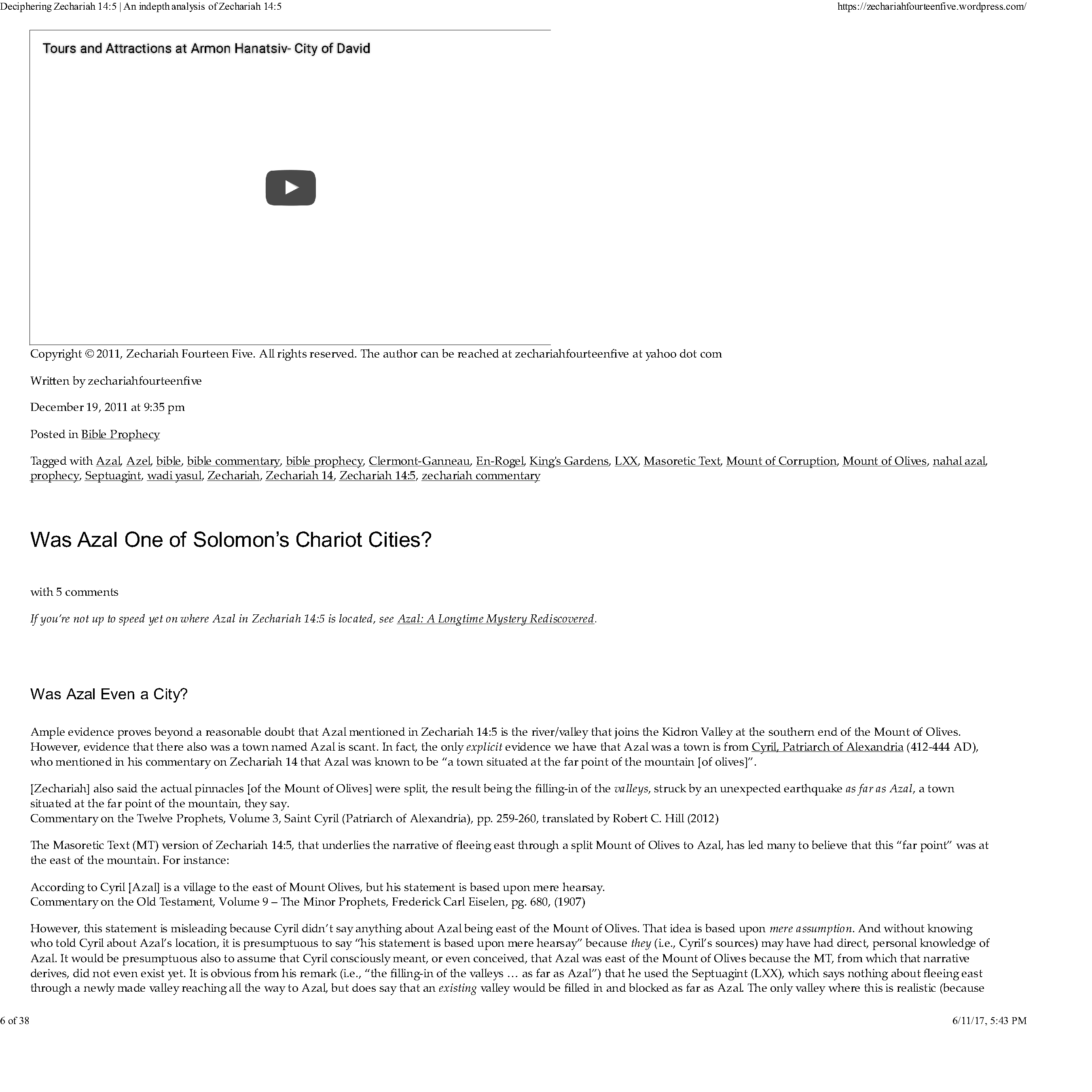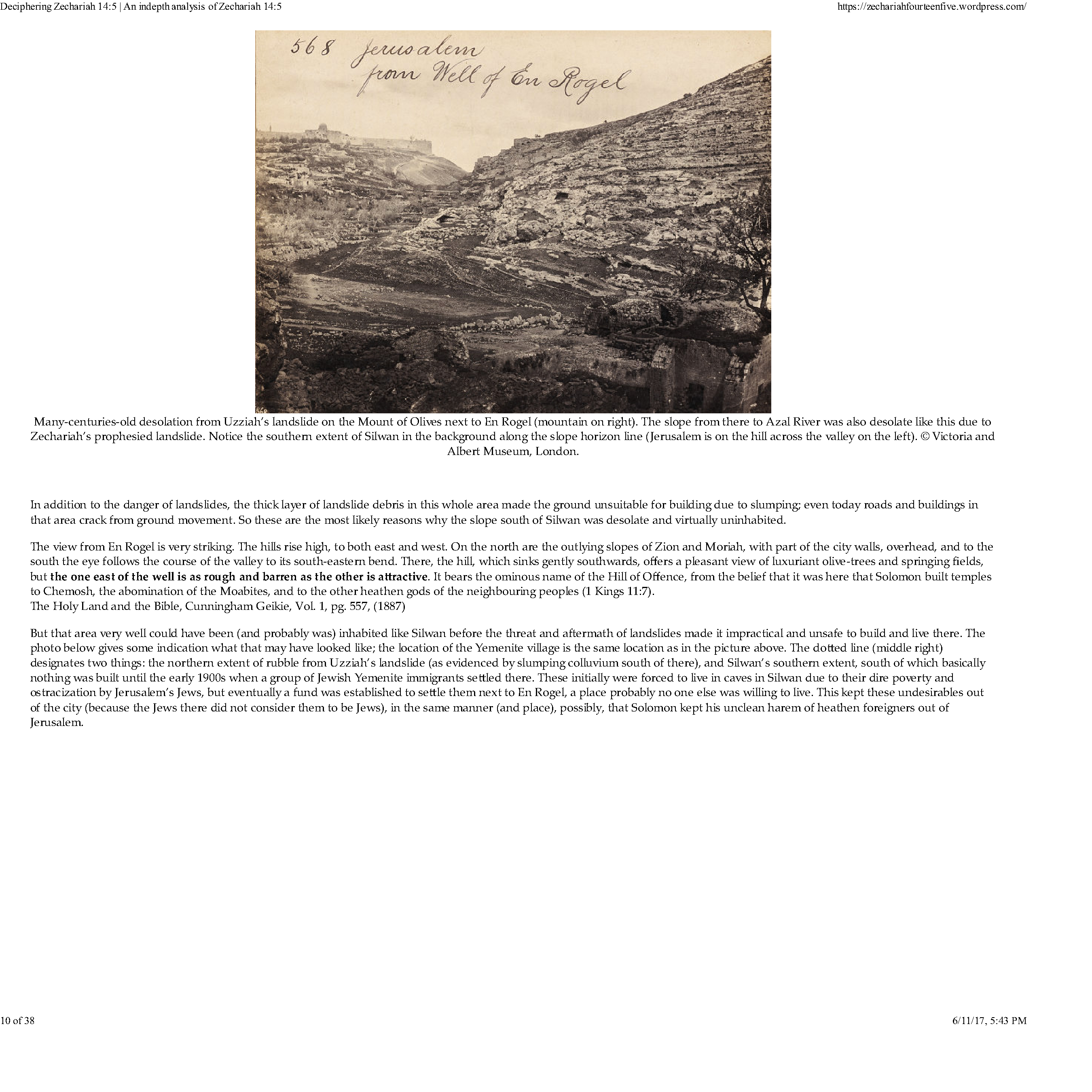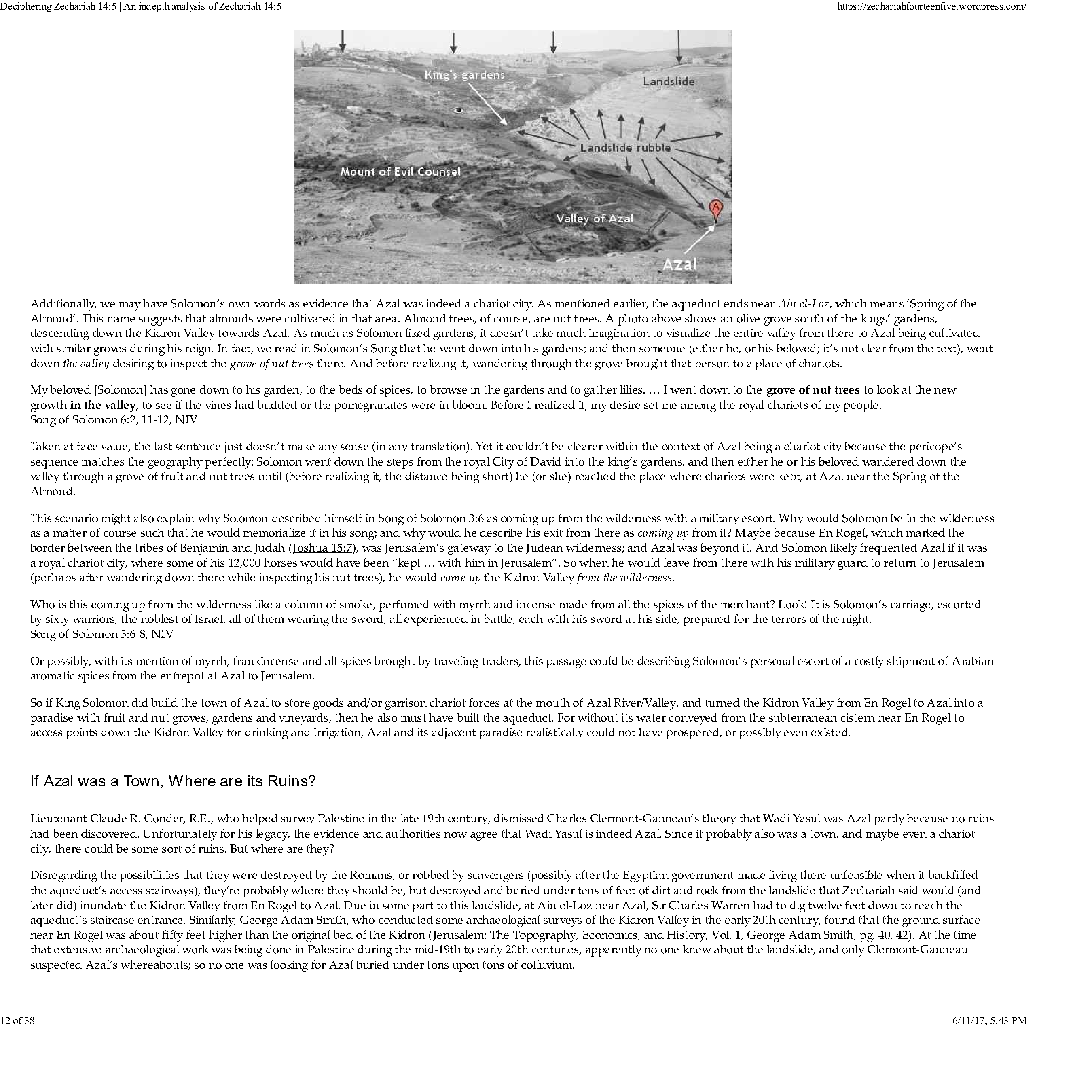Jerusalem - Landslides
 View of undated landslide above the Church of All Nations on the
Mount of Olives. Approx. Base of Fault Scarp drawn in Yellow. Slide unit marked in tinted blue
View of undated landslide above the Church of All Nations on the
Mount of Olives. Approx. Base of Fault Scarp drawn in Yellow. Slide unit marked in tinted blueAnnotations based on Wachs and Levitte (1984:Fig. 2)
Click on image for a unannotated high resolution (magnifiable) version of the photo
Photos taken by Jefferson Williams on 21 June 2023
| Transliterated Name | Language | Name |
|---|---|---|
| Jerusalem | English | |
| Yerushaláyim | Modern Hebrew | יְרוּשָׁלַיִם |
| al-Quds | Arabic | القُدس |
| Ûrshalîm-Al Quds | Arabic | أورشليم القدس |
| Bayt al-Maqdis | Arabic | بيت المقدس |
| Baitul Muqaddas | Arabic | بايتول موقادداس |
| Iliya | Arabic | يلييا |
| Ilya Bayt el-Maqdas | Arabic | يليا بايت يلءماقداس |
| Hierousalḗm | Greek | Ἱερουσαλήμ |
| Hierosóluma | Greek | Ἰεροσόλυμα |
| Aelia Capitolina | Latin | Aelia Capitolina |
| Ierosolymitana | Latin | |
| Erusałēm | Armenian | Երուսաղեմ |
| Yerushalem | Hebrew Bible | |
| Salem | Hebrew Bible | |
| City of Judah | Divided Monarchy ? | |
| The City | Lachish letters | |
| Jebus | Jebusites | |
| Uruslimmu | Sennacherib inscriptions (7th century BCE) | |
| Urusalim | el-Amarna letters (14th century BCE) | |
| Rushalimum | Egyptian Execration texts (19th-20th centuries BCE) |
- from Jerusalem - Introduction - click link to open new tab
- Figure 5 - Slope stability map
of the eastern part of Jerusalem from Wachs and Levitte (1984)

 Fig. 5
Fig. 5
Slope stability map of the eastern part of Jerusalem.
Wachs and Levitte (1984) - Figure 4 - Seismic velocities and
thickness of layers in the slide unit of the Mount of Olives landslide from Wachs and Levitte (1984)

 Fig. 4
Fig. 4
Seismic velocities and thickness of layers in the slide unit of the Mount of Olives landslide.
Wachs and Levitte (1984) - Undated landslide above the
Church of All Nations on the Mount of Olives

 View of undated landslide above the Church of All Nations on the
Mount of Olives.
View of undated landslide above the Church of All Nations on the
Mount of Olives.
- Approx. Base of Fault Scarp drawn in Yellow
- Slide unit marked in tinted blue
- Annotations based on Wachs and Levitte (1984:Fig. 2)
Click on image for a unannotated high resolution (magnifiable) version of the photo
Photos taken by Jefferson Williams on 21 June 2023 - Looking south down the Kidron
Valley where Josephus may have described the landslide at "Eroge"

 Looking south down the Kidron Valley in Silwan, East Jerusalem
Looking south down the Kidron Valley in Silwan, East Jerusalem
Josephus described a landslide at "Eroge" that was a result of the ~760 BCE Amos Quake. In his description, he wrotehalf the mountain broke off from the rest on the west, and rolled itself four furlongs (0.75 km.), and stood still at the east mountain, till the roads, as well as the king's gardens, were spoiled by the obstruction.
Since the City of David (and likely the King's Gardens) occupies the right (west) side of this Valley, if Josephus is to be believed (a dicey proposition), the slope on the left (east) side of this valley broke with the debris stopping and piling up when it encountered the slope on the right (east) side of the Valley.
Click on image for a higher resolution (magnifiable) version of the photo
Photos taken by Jefferson Williams on 21 June 2023
Arkin, Y., Michaeli, L. & Wolfson, N., 1993. Har Hazofun tunnel: geological and geotechnical site
investigation, GSI Report 18/93, Geological Survey of Israel .
Arkin, Y., Michaeli, L., Liberman, A., 1994, Har Hazofim tunnel, additional boreholes Z6 and Z7, GSI
Technical Report TR-GSII22/94 .
Arkin, Y., Michaeli, L., 1998. Strength and consistency of artificial clay-carbonates mixtures: simulations of
natural sediments .
Fantalkin, A. and Finkelstein, I. 2006. The Sheshonq I Campaign and the 8th-Century
BCE Earthquake: More on the Archaeology and History of the South in the Iron I–
IIA. Tel Aviv 33:18–42.
Frydman, S., 2000. Shear strength ofIsraeli soils. Isr. J. Earth Sci ,. 49,55-64 .
Hall, J. K., 1993. The GSI digital terrain model (DTM) completed. In R. Bogoch and Y. Eshet (Eds.), GSI
Current Research 8,47-50 .
Hall, J. K., Weinberger, R., Marco, S., Steinitz, G., 1999. Test ofthe accuracy ofthe DTM ofIsrael. Geological
Survey ofIsrael, Report TR-GSIII /9 9 .
Hatzor, Y. H., Levin, M., 1997. The shear strength of clay-filled bedding planes in limestones; back-analysis ofa
slope failure in a phosphate mine, Israel. Geotechnical and Geological Engineering . 15 (4 , ) 263-282 .
Hatzor, Y. H., Palchik, V., 1998. A microstructure-based failure criterion for Aminadav dolomites. Intemational
Joumal ofRock Mechanics and Mining Sciences and Geomechanics Abstracts . 35 (6 , ) 797-805 .
Katz, Oded, 2004, Assessing the danger of landslides during an earthquake
in the area of the city of Jerusalem, GSI Report (in Hebrew)
Lewy, Z., 1989. Correlation of lithostratigraphic units in the upper Judea Group (Late Cenomanian - Late
Coniacian) in Israel, Isr. J. Earth Sci. 38: 37-43.
Mimran, Y., 1995. Stratigraphic and geotechnical evaluation of the chalk in the Mount Scopus tunnel.
Geological Survey oflsrael, Report GSI/42/95.
Wachs, D., Levitte, D., 1983, Earthquake risk and slope stability in Jerusalem, Geological Survey of Israel ,
EG /2 /83 .
Wachs, D. and D. Levitte (1984). "Earthquake risk and slope stability in Jerusalem." Environmental Geology and Water Sciences 6(3): 183-186.
Wachs, D., Lewitte, D. (1984). "Earthquakes in Jerusalem and the Mount of Olives landslides." Israel Land & Nature 3: 118-121.
Wust-Bloch, H., Wachs, D., 2000, Seismic triggering ofunstable slopes in northem Israel. Isr. J. Earth Sci ,. 49 ,
103-109 .
- Your browser must have a pdf viewer to see this file
Wachs, D. and D. Levitte (1984). "Earthquake risk and slope stability in Jerusalem." Environmental Geology and Water Sciences 6(3): 183-186.
Wachs, D., Lewitte, D. (1984). "Earthquakes in Jerusalem and the Mount of Olives landslides." Israel Land & Nature 3: 118-121.
759 BC ? - Ambraseys (2009)
... About three centuries later, early in the sixth century BC, Zechariah (c. 520 BC) mentions an earthquake in Judaea, again in the days of King Uzziah and probably the same event as that mentioned by Isaiah, which he says affected Jerusalem and caused the Mount of Olives, east of Jerusalem, to split and form a valley [3]. The interpretation of this passage in Zechariah (14, 4-5), which seems to be a later fifth- or fourth-century-BC insertion, is not clear. Other versions of the same passage say that the Mount of Olives will split in two and create a valley that will reach Azel. This valley will run from east to west with half of the Mount of Olives moving to the north, away from the position it occupied, while the other half will move to the south. The valley will stop where the mountains will touch each other [3.1, 3-7].
A somewhat different reading is to be found in the Masoretic version, where, following the mention of the splitting of the Mount of Olives, it says that the valley shall reach unto Azal, as compared with the Revised Standard Version, which says instead that the valley shall be stopped up, for the valley shall touch the side of it (the mountain) [4, 5]. The source of this difference lies perhaps in the confused reading of the Hebrew words for `shall be stopped up' (ve-nistam), and 'you shall flee' (venastem). The consonants are identical, but when the diacritical points were added to the Hebrew Bible to facilitate reading, the text was apparently misunderstood and the meaning changed (see the editor's note in Wachs and Lewitte 1984). Upon adopting the latter reading as more plausible in relation to the natural phenomenon described, it is obvious that there is no other explanation than a large landslide, which may, or might not, have been triggered by this or by another earthquake. Also, Josephus in his Antiquities of the Jews (AD 93), a book written about six centuries later, refers to an earthquake that happened in the last months of King Uzziah's life, which caused a crack in the Temple at Jerusalem. Josephus adds that at a place called Enrogel, outside the city, half of the mountain in the west broke off from the rest and slid 800 m up to the mountain on the east, spoiling the king's gardens [6]. Assuming that the two authors refer to the same event, this passage in Josephus seems to suggest that in all probability Zechariah describes a landslide, perhaps triggered by an earthquake, rather than a graben formed by normal faulting.
There is a further reference to these events in Uzziah's days by Nathan ha-Bavli, who was writing in the middle of the second century AD. He does not mention the earthquake, but he says that at the time of the desecration of the temple by Uzziah the temple split open and the fissure extended for twelve 'miles' in each direction [6a].
The location of Azal is not certain, but the name may denote some place near the western extremity of the valley near Jerusalem or a hamlet on the outskirts of Jerusalem. As for the location of En-rogel, it has been suggested that it is the fountain of the Virgin, the modern Ain Umm al-Daraj. Others identify it with Bir Eyub, to the south of the Pool of Siloam, and below the junction of the valleys of Kidron and Hinnom, which seems to be a more probable location, but again this is not certain.
There remains the question of whether there is any evidence today for active faulting in the immediate vicinity of Old Jerusalem that can be associated with the ground deformations mentioned by Zechariah, Josephus and Nathan. Old aerial photographs of the chalky geological formations of the region show only landslides on steep slopes, but no through-going faults. A relatively large slide can be recognised on the Mount of Olives, which is located on the slope which faces west towards the Old City, the scarp of which can be seen halfway up the Mount of Olives. However, according to the Geological Survey of Israel, it is probably much more ancient than Biblical times (Wachs and Lewitte 1984; Frydman 1997). The multitude of short scarps shown on relatively recent geological maps of Jerusalem all teiminate at the Kidron Valley (Gil 1996). The exception is a short northeastsouthwest- running fault trace, which is shown on the Geotechnical Map of Jerusalem (Israeli 1977), which the Atlas of Israel labels Zechariah 14:4, earthquake fault. This feature extends from a point a few hundred metres south of the Jerusalem Railway Station to the west, running for more than three kilometres, to just north of al- Ayzariyah to the east, striking about N-70° E (Atlas of Israel1985). The reason why this feature has been associated with Zechariah's earthquake is not given. There is no direct or indirect evidence that Jerusalem was damaged, and it is interesting that the details in Josephus concerning the effects of the earthquake on the temple are not supported by earlier sources, which remain silent about damage anywhere in Judaea and Israel [7].
[1] Amos says that the prophet received visions ‘. . . during
the reigns of Uzziah king of Judah and Jeroboam son of
Jehoash king of Israel, two years before the earthquake . . .’
(Amos, I. 1).
[2] ‘. . . they shall go into the holes of the cracks and into
the caves of the earth when He arises to shake (terrify) the
earth . . .’ (Isa. II. 19, 21).
[3.1] ‘. . . the Lord will go out fully armed for war, to fight against
those nations. That day his feet will stand upon the Mount
of Olives, to the east of Jerusalem, and the Mount of Olives
will split apart, making a very wide valley running from east
to west, for half the mountain will move towards the north
and half toward the south. You will escape through that valley,
for it will reach across to Azel. You will escape as your
people did long centuries ago from the earthquake in the
days of Uzziah, king of Juda . . . [c. 767–753 BC]’ (Zech.
xiv. 4–5).
[3.2] ‘And the mountain will split in half, forming
a wide valley that runs from east to west . . . Then you people will
escape from the Lord’s mountain, through this valley,
which reaches to Azal. You will run in all directions, just
as everyone did when the earthquake struck in the time of
King Uzziah of Judah.’ (Contemporary English Version).
[3.3] ‘And the Mount of Olives shall be split in two from east
to west by a very wide valley; so that one half of the
Mount shall withdraw northward, and the other half southward . . . And the valley of my mountains shall be stopped
up, for the valley of the mountains shall touch the side of
it; and you shall flee as you fled from the earthquake in the
days of Uzzi’ah king of Judah.’ (Revised Standard Version).
[3.4] ‘And the Mount of Olives shall be split in two from east
to west by a very great valley; and half of the mountain
shall remove toward the north and half of it toward the
south . . . And you shall flee by the valley of my mountains;
for the valley of the mountains shall reach to Azel; and you
shall flee, as you fled from before the earthquake in the days
of Uzziah king of Judah.’ (Amplified Bible).
[3.5] ‘And the Mount of Olives shall be split in the midst thereof
toward the east and toward the west, and there shall be a
very great valley; and half of the mountain shall remove
toward the north, and half of it toward the south . . . And you
shall flee by the valley of my mountains; for the valley of the
mountains shall reach unto Azel. And you shall flee, like as
you fled from before the earthquake in the days of Uzziah.’
(American Standard Version).
[3.6] ‘And the Mount of Olives shall cleave in the midst thereof
toward the east and toward the west, and there shall be a
very great valley; and half of the mountain shall remove
toward the north and half of it toward the south . . . And you
shall flee by the valley of my mountains; for the valley of the
mountains shall reach unto Azal; you shall even flee, like as
you fled from before the earthquake in the days of Uzziah
king of Judah.’ (Darby English Version).
[3.7] ‘And the Mount of Olives shall cleave in the midst thereof
toward the east and toward the west, and there shall be a
very great valley; and half of the mountain shall remove
toward the north, and half of it toward the south . . . And you
shall flee to the valley of the mountains; for the valley shall
reach unto Azal; you shall flee, like as you fled from before
the earthquake in the days of Uzziah king of Judah.’ (King
James Version).
[4] ‘And ye shall flee to the valley of the mountains;
for the valley of the mountains shall reach unto Azal . . .’ (Masoretic
text).
[5] ‘And the valley of my mountains shall be stopped up; for
the valley of the mountains shall touch the side of it . . .’
(Revised text).
[6] ‘. . . a great earthquake shook the ground and a rent was
made in the temple, and the bright rays of the sun shone
through it, and fell upon Uzziah’s face, insomuch that the
leprosy seized upon him immediately. And before the city,
at a place called Eroge, half the mountain broke off from
the rest on the west, and rolled itself four furlongs and stood
still at the east mountain, till the roads, as well as the king’s
gardens, were spoiled by the obstruction . . .’ (Joseph.AN:
IX. x. 4).
[6a] ‘. . . when leprosy appeared on Uzziah’s brow, at the same
moment the temple split open and the fissure extended for
twelve miles in each direction . . .’ (Nathan ha-Bavli. ix).
[7] ‘. . . the posts of the temple moved when the Lord spoke . . .’
(2 Chron., XXVI. 16–17; 2 Kings XV.1–7).
Ambraseys, N. N. (2009). Earthquakes in the Mediterranean and Middle East: a multidisciplinary study of seismicity up to 1900.
- Whether the author is correct in his hypothesis or not, the images alone make this now deleted blog post worth saving






































- download these files into Google Earth on your phone, tablet, or computer
- Google Earth download page
| kmz | Description | Reference |
|---|---|---|
| Right Click to download | Master Jerusalem kmz file | various |